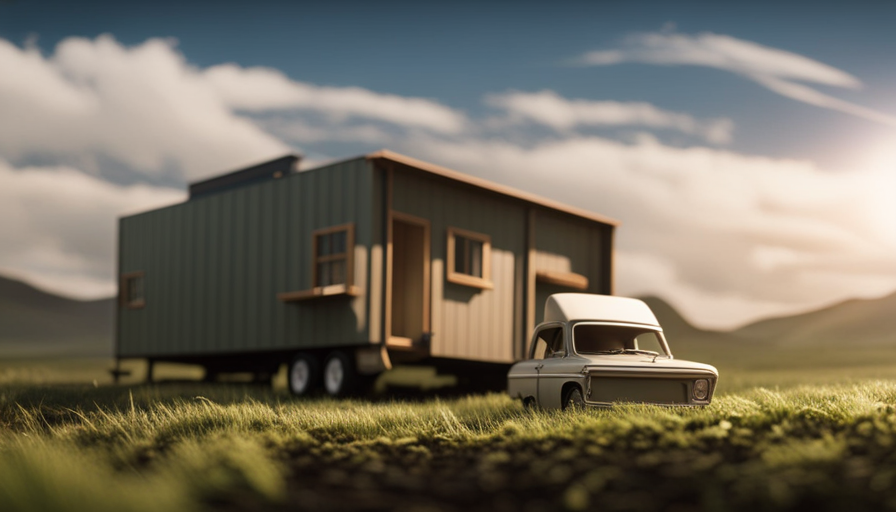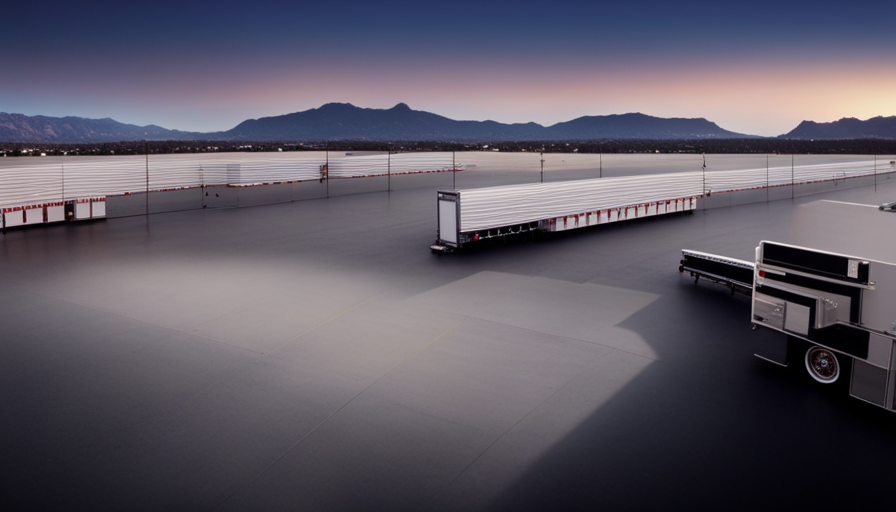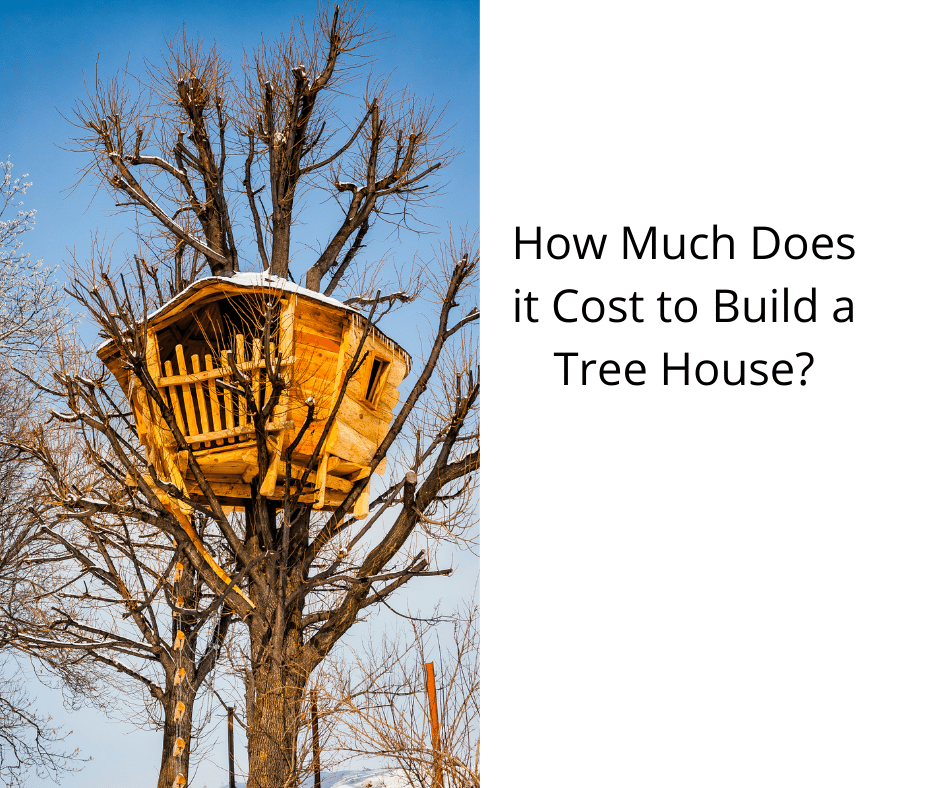Imagine a tiny, mobile house, a cozy and efficient living space that can be taken anywhere you desire. But, before embarking on your adventure with your portable home, it is crucial to understand the weight limitations of the trailer that will be carrying your small house.
Just like a finely balanced scale, the weight distribution of your tiny house is pivotal to its safety and stability on the road.
In this article, we will delve into the technical aspects of determining the maximum weight capacity of your trailer, considering the materials and construction of your tiny house, and assessing the weight of your furnishings and appliances.
We will also explore the importance of factoring in water and waste storage, abiding by legal requirements and regulations, and consulting with experienced tiny house builders and owners.
By the end, you will have the knowledge and confidence to make an informed decision about the weight of your tiny house trailer.
Key Takeaways
- Understanding weight limitations and weight distribution is crucial for the safety and stability of a tiny house on wheels.
- Choosing lightweight materials, construction techniques, and furnishings can help reduce the overall weight of the tiny house.
- Consider the weight of additional features like solar panels, batteries, HVAC systems, and plumbing systems when determining the weight capacity of the trailer.
- It is important to comply with local regulations and abide by weight limits for towing to avoid fines, impoundment, and insurance denial.
Understanding the Weight Distribution of Your Tiny House
You’ll need to understand how the weight is distributed in your tiny house on wheels to ensure it’s properly balanced and travels smoothly behind your vehicle.
The importance of weight distribution in towing a tiny house can’t be overstated. If the weight isn’t distributed evenly, it can lead to an unstable and unsafe towing experience. The impact of weight distribution on the overall stability of a tiny house is significant. Uneven weight distribution can cause the trailer to sway or fishtail, making it difficult to control and increasing the risk of accidents.
To determine the weight distribution, you should consider the placement of heavy items such as furniture, appliances, and water tanks. These items should be evenly distributed throughout the house to maintain balance. It’s also important to keep in mind that the weight distribution can change depending on the specific design and layout of your tiny house.
Understanding the weight distribution will help you determine the maximum weight capacity of your trailer. By knowing the weight distribution, you can calculate how much weight can be safely towed without putting too much strain on your vehicle. This information will be crucial in ensuring a smooth and stable towing experience.
Determining the Maximum Weight Capacity of Your Trailer
Determining the maximum weight capacity of your mobile home’s transportation unit is crucial, as it can typically handle loads equivalent to the weight of approximately five adult elephants. Understanding weight limits and trailer towing capacity is essential to ensure the safety and stability of your tiny house on wheels.
To determine the maximum weight capacity of your trailer, you need to consider a few factors. Firstly, consult the manufacturer’s specifications for the trailer to find its maximum towing capacity. This information is usually provided in the owner’s manual or can be obtained from the manufacturer directly.
Additionally, you need to account for the weight of the tiny house itself, including all the furnishings, appliances, and personal belongings that will be inside.
It’s important to note that exceeding the trailer’s weight limit can lead to structural damage, increased wear and tear on the tires and suspension, and even pose a safety risk while towing. Therefore, it is crucial to carefully calculate the weight of your tiny house and ensure it falls within the trailer’s maximum weight capacity.
Considering the materials and construction of your tiny house will be discussed in the subsequent section, which is vital for maintaining the overall weight and stability of your mobile home.
Considering the Materials and Construction of Your Tiny House
When considering the materials and construction of my tiny house, two key points to take into account are the weight of different building materials and the impact of construction techniques on weight.
Understanding the weight of different materials is crucial in determining the overall weight of the tiny house and its effect on the trailer’s capacity.
Additionally, the construction techniques used can greatly influence the weight of the house, as certain methods may require more materials or result in a heavier structure.
Weight of Different Building Materials
If you’re considering building a tiny house on wheels, keep in mind that the weight of different building materials can significantly impact the overall weight of your trailer. When it comes to the weight of insulation, it’s important to choose materials that provide adequate insulation while being lightweight.
For example, fiberglass insulation is a popular choice due to its low weight and high insulating properties. Additionally, the impact of interior design should not be overlooked. Opting for lightweight furniture, fixtures, and appliances can help reduce the overall weight of your tiny house. Consider using materials such as lightweight aluminum or composite wood for these elements. These choices can greatly impact the towing capacity and maneuverability of your tiny house on wheels.
Transitioning to the subsequent section, the impact of construction techniques on weight is another crucial aspect to consider.
Impact of Construction Techniques on Weight
Using innovative construction techniques can significantly reduce the weight of your portable home, allowing for easier towing and increased maneuverability. The impact of design choices cannot be overstated when it comes to the weight of a tiny house on wheels. By opting for lightweight materials such as aluminum or composite panels for the walls and roof, you can greatly reduce the overall weight of the structure.
Additionally, choosing insulation methods that provide effective thermal protection while minimizing bulk can further decrease the weight of your tiny house. For example, using spray foam insulation or insulated panels can provide excellent insulation properties without adding excessive weight. Considering these factors during the design phase can help ensure that your tiny house remains lightweight without compromising on comfort or energy efficiency.
Transitioning into the subsequent section about assessing the weight of your furnishings and appliances, it’s important to carefully consider the impact they’ll have on the overall weight of your tiny house.
Assessing the Weight of Your Furnishings and Appliances
To figure out just how much your furnishings and appliances weigh, you’ll need to channel your inner Hercules and embark on a quest to weigh every single item in your tiny house on wheels. Assessing the weight of your furnishings and appliances is crucial for determining the weight distribution and calculating the weight capacity of your trailer. This information is essential to ensure the safe transportation of your tiny house on wheels.
To help you visualize this process, imagine a table with three columns and three rows. In the first column, list the item, such as a sofa, dining table, or refrigerator. In the second column, record the weight of each item in pounds. Finally, in the third column, calculate the total weight of all items. This table will provide a clear overview of the weight distribution and help you assess whether your trailer can handle the load.
Once you have assessed the weight of your furnishings and appliances, you can move on to factoring in water and waste storage. This step is crucial for determining the overall weight of your tiny house on wheels and ensuring that your trailer can support the additional weight of these systems.
Factoring in Water and Waste Storage
After assessing the weight of your furnishings and appliances, it’s important to consider the additional weight of water and waste storage systems to ensure the overall stability and capacity of your mobile dwelling.
Water storage is a crucial aspect of tiny house living. It provides a self-sufficient water source for everyday needs such as cooking, cleaning, and showering. When calculating the weight of water storage, it’s necessary to account for the size and capacity of the tanks or containers, as well as the weight of the water itself.
Waste management is another vital consideration. It involves the proper disposal and containment of sewage and graywater. This typically requires the installation of a wastewater holding tank or a composting toilet system. These components add substantial weight to the trailer, and their placement should be carefully considered to maintain the balance and structural integrity of the tiny house on wheels.
Understanding the impact of additional features and amenities, such as solar panels or a rooftop garden, is the next step in ensuring the overall weight and functionality of your mobile dwelling.
Understanding the Impact of Additional Features and Amenities
When considering the weight of solar panels and batteries for a tiny house on wheels, it’s crucial to factor in the impact on the overall weight of the trailer. The weight of these additional features can significantly affect the towing capacity and maneuverability of the tiny house.
Furthermore, it’s essential to consider the weight of HVAC systems, as they can further contribute to the overall weight and potentially limit the options for a suitable trailer.
Weight of Solar Panels and Batteries
Don’t underestimate the weight of solar panels and batteries for your tiny house on wheels. When designing your off-grid power system, it’s crucial to consider the impact of these components on the overall weight of your trailer. Here are five key factors to keep in mind:
- Solar panel efficiency: Higher efficiency panels can produce more power with less surface area, reducing weight.
- Battery lifespan: Opt for durable batteries with a longer lifespan to minimize the need for replacements, reducing long-term weight concerns.
- Battery capacity: Consider the size and weight of the batteries required to meet your energy needs, balancing power requirements with weight limitations.
- Mounting system: Choose lightweight and sturdy mounting systems to secure your solar panels without adding unnecessary weight.
- Wiring and connectors: Use lightweight wiring and connectors to minimize the weight of your electrical system.
Considering the weight of HVAC systems is another crucial aspect to ensure your tiny house on wheels is properly balanced and safe.
Considering the Weight of HVAC Systems
Now that we’ve discussed the weight of solar panels and batteries, let’s delve into another important aspect of designing a tiny house on wheels: the weight of HVAC systems.
When considering the weight of your HVAC system, it’s crucial to account for not only the actual unit itself, but also the weight of the ductwork and any additional components such as vents and registers.
The weight of plumbing systems should also be taken into consideration, as pipes and fixtures can add significant weight to your tiny house.
Additionally, it’s important to note that insulation plays a role in the overall weight of your tiny house. While insulation is essential for energy efficiency and comfort, it can also add to the weight of your structure. Therefore, it’s crucial to carefully select insulation materials that strike a balance between weight and performance.
Ensuring the safety and stability of your tiny house requires careful consideration of each component’s weight and its impact on the overall structure.
Ensuring the Safety and Stability of Your Tiny House
To ensure the safety and stability of your tiny house, it’s important to make sure the trailer is the appropriate weight for your needs. Weight distribution plays a crucial role in maintaining the structural integrity of your tiny house on wheels. The trailer should be able to support the weight of the entire structure, including all the furnishings and appliances inside.
It is essential to consider the maximum weight capacity of the trailer and ensure that your tiny house does not exceed it. Abiding by legal requirements is also crucial in ensuring the safety and stability of your tiny house. Different jurisdictions may have specific regulations regarding the weight of trailers and tiny houses.
It is important to familiarize yourself with these regulations and ensure that your tiny house complies with them. Failure to adhere to legal requirements can result in fines or even the inability to move or park your tiny house.
By carefully considering weight distribution and abiding by legal requirements, you can ensure that your tiny house on wheels is safe and stable. This will provide you with peace of mind as you enjoy the mobility and flexibility that comes with living in a tiny house.
Abiding by Legal Requirements and Regulations
Ensuring compliance with legal requirements and regulations is crucial for maintaining the safety and stability of your compact dwelling. When it comes to towing a tiny house on wheels, abiding by local regulations is of utmost importance. Different regions may have varying rules and restrictions in place, so it’s essential to familiarize yourself with the specific requirements in your area.
One key aspect to consider is the weight limits for towing. Most jurisdictions have set limits on the maximum weight that can be towed on public roads. Exceeding these limits can not only result in legal consequences but can also pose a significant safety risk. Therefore, it’s vital to carefully calculate the weight of your tiny house, including all the furnishings and personal belongings, to ensure that it falls within the allowable limits.
To evoke a sense of responsibility and caution in the audience, consider the potential consequences of disregarding these regulations. This can include hefty fines, vehicle impoundment, or even the denial of insurance claims in case of an accident. Additionally, disregarding weight limits can compromise the structural integrity of your tiny house, leading to potential damage or instability during transportation.
By abiding by local regulations and adhering to weight limits for towing, you can ensure the safety of your tiny house on wheels. Consulting with experienced tiny house builders and owners can provide valuable insights and guidance on how to navigate these legal requirements effectively.
Consulting with Experienced Tiny House Builders and Owners
When it comes to building a tiny house, seeking advice from professionals in the field is crucial. Their expertise and experience can provide valuable insights and guidance on various aspects, such as design, construction techniques, and legal requirements.
Additionally, learning from the experiences of other tiny house dwellers can offer practical knowledge of what works and what doesn’t, helping to avoid potential pitfalls and optimize the overall living experience.
Seeking Advice from Professionals in the Field
Get insights from professionals in the field to make sure you choose the right weight for your tiny house on wheels. When it comes to determining the weight of a trailer for a tiny house, professionals’ recommendations and expert opinions are invaluable.
Consulting with experienced professionals such as engineers, architects, and trailer manufacturers can provide you with accurate information regarding the weight capacity and structural requirements of the trailer. These professionals have extensive knowledge and experience in designing and building tiny houses on wheels, and they can guide you in selecting the appropriate trailer that can safely support the weight of your tiny house.
Additionally, they can offer insights on factors such as axle placement, suspension systems, and overall trailer design that can affect the weight distribution and towing stability. By seeking advice from professionals in the field, you can ensure that your tiny house on wheels is built on a solid foundation.
Learning from the experiences of other tiny house dwellers will further enhance your understanding of the weight considerations.
Learning from the Experiences of Other Tiny House Dwellers
After seeking advice from professionals in the field of tiny house construction, I decided to delve into the experiences of other tiny house dwellers. Learning from their mistakes and gaining insights from their journeys has been invaluable.
One common theme that emerged was the importance of weight management when it comes to choosing a trailer for a tiny house on wheels. Many dwellers shared tips on how to keep the weight of the trailer and the overall house within acceptable limits. From using lightweight materials for the build to carefully considering the weight of appliances and furniture, these tips have helped me understand the intricacies of weight distribution and its impact on towing and stability.
By incorporating these lessons into my planning process, I feel more equipped to make an informed decision for my tiny house trailer, ensuring a safe and efficient journey.
Making an Informed Decision for Your Tiny House Trailer
To make an informed decision for your tiny house trailer, you’ll want to consider the weight and size of your tiny house to ensure a perfect fit.
One crucial aspect to consider is weight distribution. Proper weight distribution is vital to ensure stability and safety while towing your tiny house. You need to distribute the weight evenly across the trailer to prevent any excess strain on specific areas. This can be achieved by placing heavier items such as appliances or furniture towards the center of the trailer.
Additionally, you should also be mindful of the weight capacity of your trailer. Each trailer has a maximum weight capacity that it can safely handle. Exceeding this weight limit can lead to structural damage and compromise the overall integrity of the trailer. It is essential to know the weight of your tiny house and ensure it falls within the weight capacity of the trailer you choose.
By considering weight distribution and weight capacity, you can make an informed decision and select a trailer that can safely accommodate your tiny house.
Frequently Asked Questions
How much weight can my tiny house trailer safely hold?
My tiny house trailer has an incredible towing capacity that can safely hold a substantial amount of weight. With careful weight distribution, I can confidently transport all my belongings without worrying about exceeding the trailer’s limits.
It’s crucial to ensure that the weight is evenly distributed to maintain stability and prevent any potential damage. Keeping these factors in mind, my tiny house trailer can handle the weight with ease.
What are the legal requirements and regulations for towing a tiny house on wheels?
When it comes to towing a tiny house on wheels, there are important legal requirements and regulations to consider. These include having a proper towing vehicle with the necessary capacity, obtaining the appropriate driver’s license, and adhering to weight restrictions and size limits imposed by local transportation authorities.
Common mistakes when towing a tiny house include exceeding weight limits, improper hitching, and inadequate braking systems. It’s essential to familiarize oneself with these regulations to ensure safe and legal towing.
What safety measures should I take to ensure the stability of my tiny house while towing?
To ensure trailer stability while towing my tiny house, I follow these essential tips.
Firstly, I carefully distribute the weight inside the house, placing heavier items near the axles.
Secondly, I make sure the trailer’s tires are properly inflated and in good condition.
Additionally, I use weight distribution hitches and sway control devices to minimize any potential swaying.
Lastly, I regularly inspect the trailer’s brakes, lights, and suspension for optimal safety.
These tiny house towing tips guarantee a stable and secure journey.
Are there any specific materials or construction techniques recommended for building a tiny house on wheels?
Recommended materials and construction techniques for building a tiny house on wheels depend on various factors such as weight, durability, and mobility.
Popular choices for materials include lightweight yet sturdy options like steel or aluminum frames, as well as composite panels for insulation.
Construction techniques like advanced framing or SIPs (structural insulated panels) can optimize strength and energy efficiency.
It’s crucial to consider these factors to ensure a well-built, safe, and efficient tiny house on wheels.
How do I determine the weight of my furnishings and appliances to ensure that I stay within the trailer’s weight capacity?
To determine the weight capacity and calculate the trailer weight, I must carefully assess the furnishings and appliances for my tiny house on wheels.
First, I need to obtain the weight specifications for each item from the manufacturer or product documentation.
Then, I will add up the individual weights to obtain the total weight of all furnishings and appliances.
Finally, by subtracting this total weight from the trailer’s weight capacity, I can ensure that I stay within the allowed limit.
Conclusion
After carefully considering the weight distribution, maximum capacity, materials, furnishings, and legal requirements, I’ve come to a well-informed decision for my tiny house trailer.
It’s crucial to balance the weight like a tightrope walker, ensuring stability and safety on the road. Like a puzzle, each piece must fit perfectly, creating a harmonious structure.
By consulting experienced builders and owners, I’ve gained valuable insights, like a compass pointing me in the right direction.
Now, equipped with knowledge and precision, I’m ready to embark on my tiny house journey.
Hi, I’m Emma. I’m the Editor in Chief of Tiny House 43, a blog all about tiny houses. While tree houses are often associated with childhood, they can be the perfect adult retreat. They offer a cozy space to relax and unwind, surrounded by nature. And since they’re typically built on stilts or raised platforms, they offer stunning views that traditional homes simply can’t match. If you’re looking for a unique and romantic getaway, a tree house tiny house might just be the perfect option.










